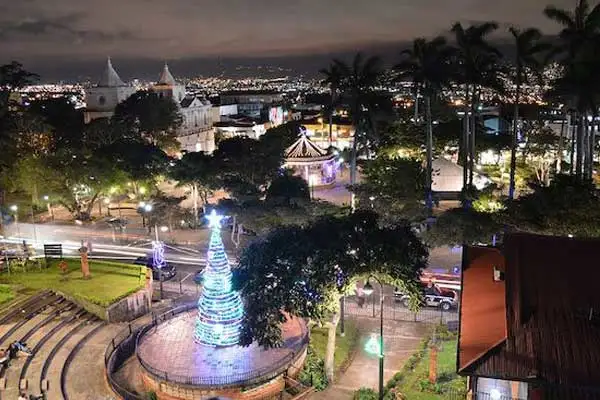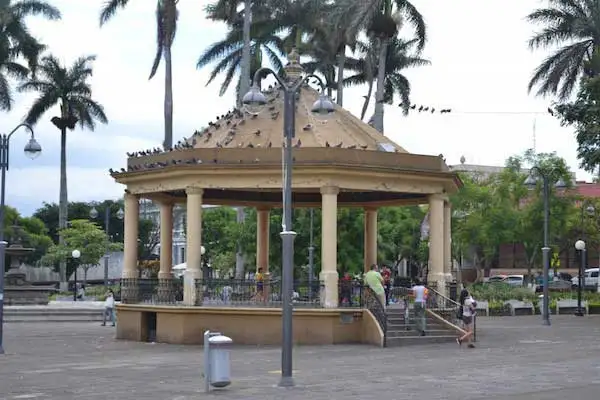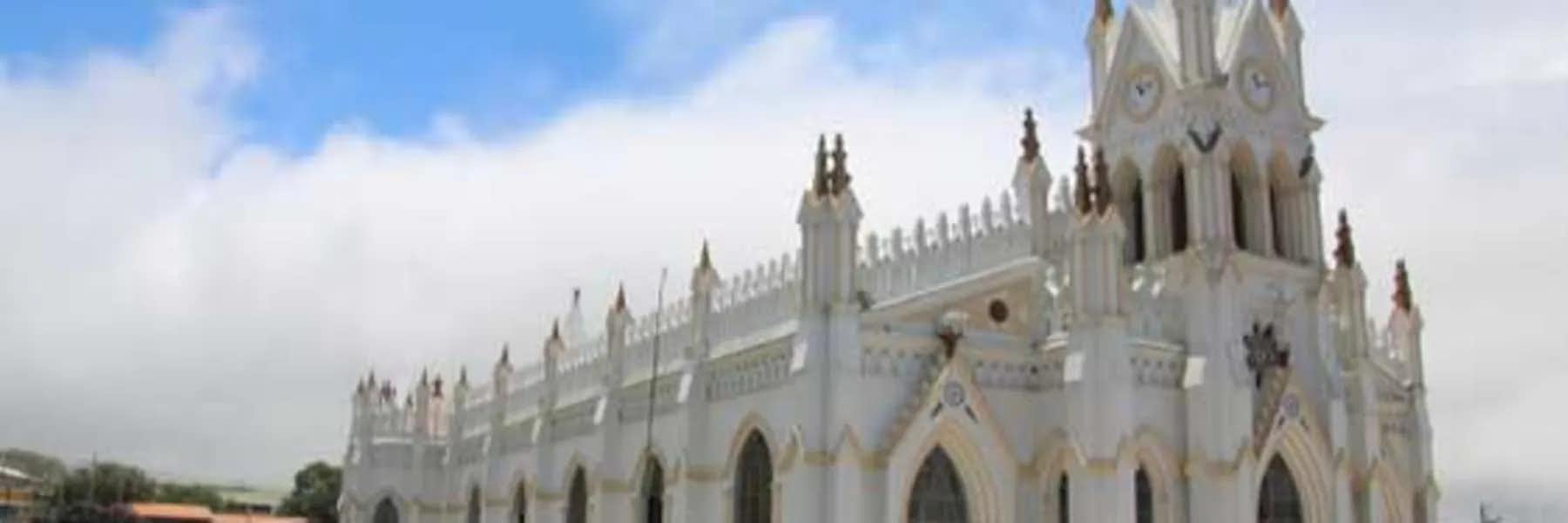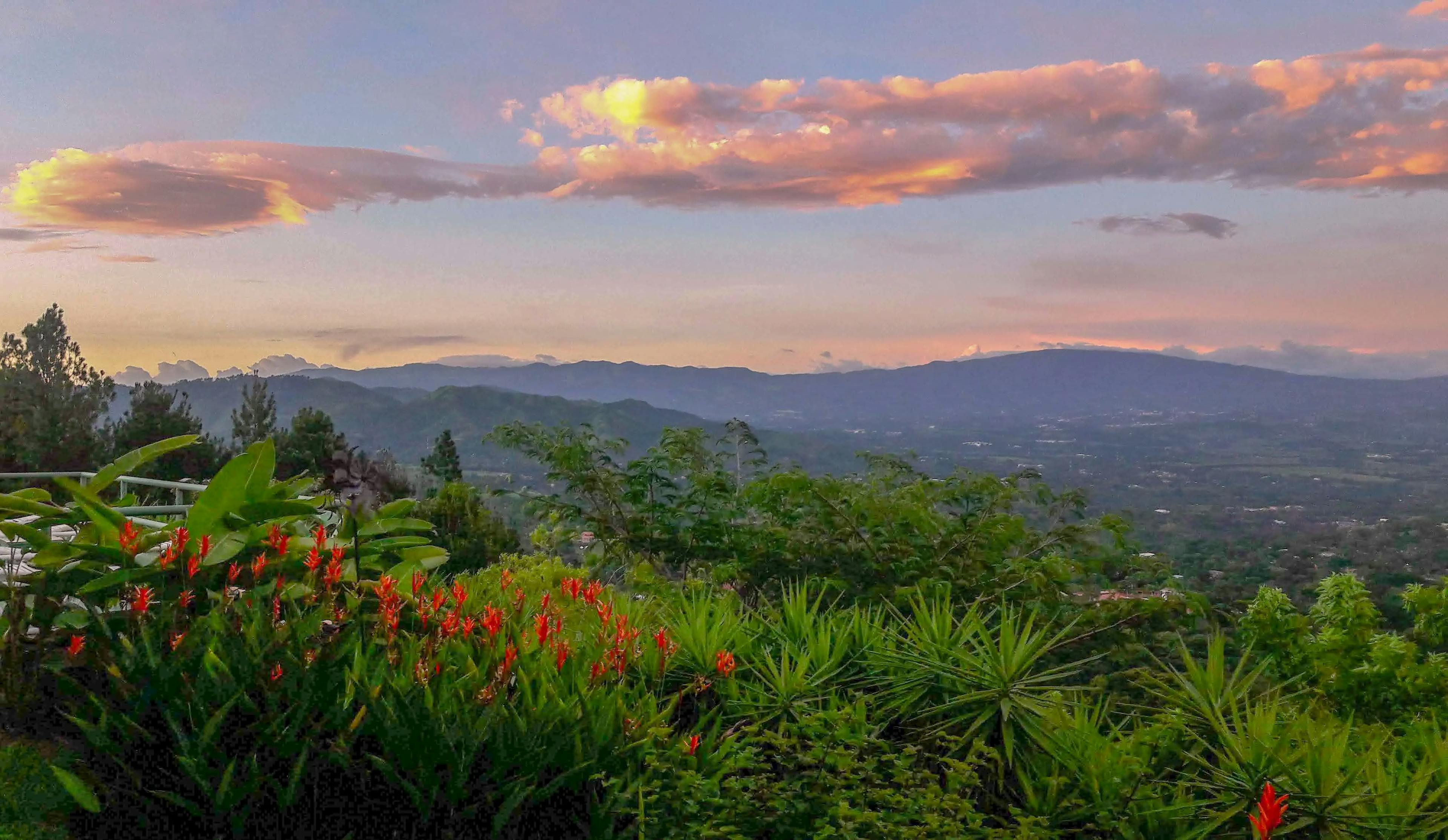By Lou Kritz
Heredia, the fourth largest city in Costa Rica, can actually lay claim to being right in the middle of all the action, both geographically and commercially. The city of Heredia is the main northern community in the San José Metropolitan Area and borders the San José province, or state-like division. It extends westward to the Pan-American Highway, route 1, almost to the main airport, and eastward towards Cartago. The Province of Heredia spreads northwards through the mountainous country all the way to the Nicaraguan border. Uniquely, Heredia is commercially active yet close to the rural areas of mountains, volcanos, and coffee fields. It is nine miles north of San José at an elevation of 3,773 feet. Year-round temperatures of 77 F provide mild summer comfort all year long.
Commercial activities spread from agriculture, largely high-quality mountain coffee, to a vibrant and growing technology industry presence. Real estate varies from older architecture that is well maintained to newer, modern, steel and glass high-rises and office buildings. Even the populace is a mix. Spend time in the community and you'll be greeted by elderly residents, a stable middle class, and large student representation.
Heredia sprung from an indigenous settlement of people of the Huetares tribe from about the 16th century. Traditionally, 1705 is considered the start of the current community as migrant people began settling there. In 1760 the first church was established, and in May, 1812 it obtained the designation as a municipality, and was called the "City of Flowers." 19,000 residents were counted in the 2011 census. The 2021 count is expected to be significantly higher in both Heredia city and the Heredia cantón, or county. The population is a diverse mix of commercial business people, long-term residents, workers in many different industries, and students in the university.
Get Your Free Costa Rica Report Here
Get Your Free Costa Rica Report Here
Learn more about Costa Rica and other countries in our daily postcard e-letter. Simply enter your email address below and we’ll send you a FREE REPORT - Explore the Old World in Laidback Costa Rica.

By submitting your email address, you will receive a free subscription to IL Postcards and special offers from International Living and our affiliates. You can unsubscribe at any time, and we encourage you to read more about our Privacy Policy.
Retire in Heredia

Retirement options in real estate abound. What started as a small village high on a hill overlooking San José has grown into one of the most cosmopolitan areas. Older, architecturally significant homes are surrounded with newer apartment developments and houses of all types. Prices will be slightly higher because of the ongoing growth, but also because the barrio has so much more to offer. Center-city enclaves can be high, but a move northward, toward less developed neighborhoods, provides many reasonably priced homes to buy or rent.
Along with housing, shopping opportunities include a number of malls, and a large selection of shops and stores offering everything from imports of U.S. goods to local wares, clothing, and specialty items. Food choices are abundant, also. Begin at the Friday-Saturday feria, or farmers' market, for vegetables, fruits, meats and fish, and cheese. It's all locally produced and picked the night before or the morning of. Many items are organic. Many grocery stores, both small corner pulperias and large supermarkets, will serve you well.
For transportation, streets and highways are well developed, although mid-town parking can be a strain. Public transportation includes the Incofer train line that connects Alajuela, Heredia, San José, and Cartago. This system is in the process of being aggressively upgraded with new electric trains and railway upgrades. The bus system is excellent with local, mid-range, and long-distance runs for very low rates. There are two taxi systems. The red ones with the yellow triangles on the door are government-controlled with rates starting at a dollar. The average trip is probably $3 to $4. There are independents, uncontrolled piratas or “pirates”, that should be avoided.
Medical care is easy and affordable. CAJA, the country's government-provided system, will cost from $50 to $100 per couple, based on retirement income. There are no other charges, like copays, and so forth. General medicine, hospital care, surgery, ophthalmology, hearing care, specialist care, all prescriptions, and basic dental care are included. There is also a private system, at 10% to 30% of U.S. rates, should you care to go that direction. Insurance is available for the private system. The medical care available consistently ranks in the top of the “world’s best” list, while the U.S. comes in at number 20 to 24.
Retirees in Heredia will enjoy the ongoing balmy, spring-like temperatures thanks to the pleasant elevation. There are two seasons. Dry season, or summer, lasts from early December through April. Rainy season, or winter, runs from early May through November. It's backwards, but it works here!
The vibe of Heredia is "happening!" Its proximity to San José, with all that the city has to offer, and the neighboring mountain area that turns more rural, coupled with an economy that has welcomed over 30 international companies, shows how exciting this city can be. The Free-Trade Zone welcomes Sykes, IBM, Baxter, Scotiabank, Boston Scientific, Amazon, Hewlett Packard, and many more. Progressive businesses call Heredia home. It is close to the main campus of Universidad Nacional Costa Rica (UNA), or the National University of Costa Rica, one of the five national schools. Yearly, 12,000 students earn bachelor’s and master’s degrees in a wide range of majors.
Lifestyle in Heredia

Choose your preference in living accommodations. Rentals of both apartments and houses are in abundance, along with market properties from condominiums to houses of every category. While prices in some preferred areas tend toward the high side, there are many quality barrios and neighborhoods that are more reasonable and popular.
Your home will be close to historic sites where beautiful architecture surrounds you. There are many social groups and activity centers to keep you busy. The university and other schools offer enrichment programs, and there are volunteer opportunities. All of this can be sandwiched in between shopping excursions and theater events.
If all of this can't fill your days, you will find that you are reasonably close to the mountains that showcase volcanos and nature, or the coasts for beach life and sport fishing. Then add to all of this an exciting dining and entertainment community, and your social calendar is full.
Cost of Living in Heredia

The following is a range of expected expenses, based on options to fit your lifestyle choices.
| Rent | $800 to $2,500 |
| Utilities | $100 to $400 |
| Groceries | $400 to $800 |
| Medical/CAJA | $150 to $600 |
| Dining/Entertainment | $122 to $202 |
| Transportation | $60 to $650 |
| Household Help & Incidentals | $100 to $220 |
| Total: | $1,732 to $5,372 |
Notes:
Rent: $800 is comparable to rents in other areas of Costa Rica. Luxury units, both houses and apartments, can go higher than $2,500, but the majority fit within this limit. For example, an average rental home in the Bosques de Doña Rosa section of Heredia offers a living room, kitchen/dining area, three bedrooms, two-and-a-half baths, and a laundry area. It also has two private parking spaces and room for an outdoor garden. It is available for rent at $1,150.
Groceries: Using mostly native Costa Rican items allows for budgetary savings, and the food quality is simply better.
Medical: Using mostly CAJA, with just a few over-the-counter items, makes this reasonable. Even at the higher end, for more private care, costs are significantly lower than standard U.S. care.
Dining/Entertainment: One lunch at a soda or corner eatery for two, $12, one dinner per week at a family restaurant, $30, and one gourmet meal, $80, totals $122, plus $80 for those martinis and munchies after the show.
Transportation: Low end is buses and taxis only, or $650 for your own car and all its costs.
Household Help: Cleaning help is $22 to $28 per day, plus gardener and general help.
Get Your Free Costa Rica Report Here
Get Your Free Costa Rica Report Here
Learn more about Costa Rica and other countries in our daily postcard e-letter. Simply enter your email address below and we’ll send you a FREE REPORT - Explore the Old World in Laidback Costa Rica.

By submitting your email address, you will receive a free subscription to IL Postcards and special offers from International Living and our affiliates. You can unsubscribe at any time, and we encourage you to read more about our Privacy Policy.
Things to Do in Heredia

You have found your home, began the residency process, and unpacked all of your "stuff." Now it's time to explore this beautiful and intriguing city you have selected.
Learn How it all Started
Beginning with history, you'll learn that ticos view it as something more relevant than an old statue. When you're ready to stretch your legs, begin by walking to Nicolas Ulloa Soto Central Park, declared a historic heritage site in 1994. The park is also home to Catedral de la Inmaculada Concepcion (Church of the Immaculate Conception). In 1736 it began as a straw edifice, and in 1797 the present-day stone, marble, and gold icon of immeasurable beauty was created.
Nearby is the first modern building of Heredia, the Republic of Argentina School, now housing the Regional Education Department of Heredia. Another historical heritage site, declared so in 1982, is the Government, Mail and Telegraph Building which opened in 1915. Today it is heavily used for many governmental functions, especially the mail service. Also see the Municipal Palace, an adobe building from 1870 that today houses the headquarters of the City Police. In it, you can see the fabled sculpture of Neptune created in 1863 by Fadrique Gutierrez, along with the outdoor statue La Madre, The Mother, created by Miguel Brenes Paniaugua in 1988.
End today's stroll at El Fortín, The Fort, a 1876 tower built as a defense of the city. The portholes are designed in reverse and have become the talking point of the design. In 1992 The Fort was designated as the official symbol of Heredia.
Wait, There's More!
Back in the center of town you will see works from Costa Rican sculptor Juan Rafael Chacon Solares, who introduced stone sculpture to the country. His fame parallels that of Aquileo J. Echeverria Zeledon (1866-1909), the journalist who published works depicting the rural Costa Ricans of the time as ambitious, hard-working, and full of love and humor. He is commemorated by a six-foot marble statue for his efforts to develop literary art.
Another must-see is the historical and cultural heritage site, now called the Heredia Cultural House. It was the home of the country's 21st president, Alfredo Gonzalez Flores. The adobe house is now used for art exhibitions, meetings, and artistic and creative activities. Close by is the Joaquin Lizano Gutierrez School, now the Liceo de Heredia, or Heredia High School, which was declared an architectural heritage sight in 1992 because of its artistry and beauty.
Finish your day at The Old Match Factory, built in the 1940s in Art Deco style. Somebody “flicked a Bic” and the building was taken over several times before its present use as the Science and Arts University of Costa Rica.
Let's Go Where the Smart Kids Go
Universidad Nacional de Costa Rica (UNA), or the National University of Costa Rica, is one of the five public universities in Costa Rica, and is headquartered in Heredia. In addition to catering to 12,000 students in a wide range of majors, it offers 16 Master of Arts degrees. It is also the home of the Volcanological and Seismological Observatory (OVSICORI). Spend a day visiting the tectonic observatory and learning about the interesting courses.
Let's Eat!
Now that you're drenched in history, art, architecture, and education, you're probably hungry. Heredia has the answer with a lively, gustatory effort aimed at making you full and happy. Begin with a few sodas, small eateries run by a grandma-like lady from a counter on her patio. It will taste homemade, because it is, and dinner and a drink will cost you $6 or less. The many cafeterias—not buffets, but coffee shops with fresh Costa Rican brews and pastries—will wake you up as you continue exploring.
The city dining scene is filled with spots like Ekeko Perú & Grille, Nonnó Pizzeria, the Artisan Brew Pub, the Taj Mahal, Katta Pub, and El Local Burger y Pizza, just to name a few from the large selection out there. Enjoy!
Give a Little Back
The day may come that you'd like to share some of your knowledge and generosity in a volunteer environment. A large non-profit has amazingly developed many programs in diverse areas. Check out www.workaway.com for opportunities to share.
A Short Day Trip
Three miles northwest of Heredia is Santa Barbara, home to a unique business, split in two. The first is the Ark Herb Farm, a botanical garden featuring everything that grows. Tours and education for everyone from plain, old plant lovers, to botanists, doctors, and pharmacists, make this an enjoyable rest stop and learning experience. The second part is the Costa Rica Meadery, where they produce artisanal-quality alcoholic beverages from pure honey and botanical ingredients from their farm. Their bottle shop will send you home ready to party.
Time to Get Out of Town
There's an area 20 to 30 miles north of town that is certainly a day trip, and could expand into an overnight stay as you fall in love with all of the offerings. The furthest point is the Poás Volcano. Online reservations are required get the earliest tour time you can, usually 8:00 a.m. About an hour later misty clouds roll in and obscure the site.
Also in the vicinity are the La Paz Waterfall Gardens Nature Park, an all-day wonderland of plants, native animals and birds, and spectacular falls. See the Doka Estate Coffee Plantation and Tour, the country's best presentation by a serious grower of the bean. The Corso Dairy Farm tour features farm animals, especially dairy cows, and organic strawberries. They have a restaurant, bakery, and make their own cheese and ice cream.
In the village of Vara Blanca there is a coffee/gift/candy shop that is a treat, and a tico restaurant that is like home. You will traverse through Fraijanes, the strawberry capital of Costa Rica, with its produce and fruit stands and many restaurants.
Featured Image Copyright: ©iStock/artiste9999
Get Your Free Costa Rica Report Here
Get Your Free Costa Rica Report Here
Learn more about Costa Rica and other countries in our daily postcard e-letter. Simply enter your email address below and we’ll send you a FREE REPORT - Explore the Old World in Laidback Costa Rica.

By submitting your email address, you will receive a free subscription to IL Postcards and special offers from International Living and our affiliates. You can unsubscribe at any time, and we encourage you to read more about our Privacy Policy.















